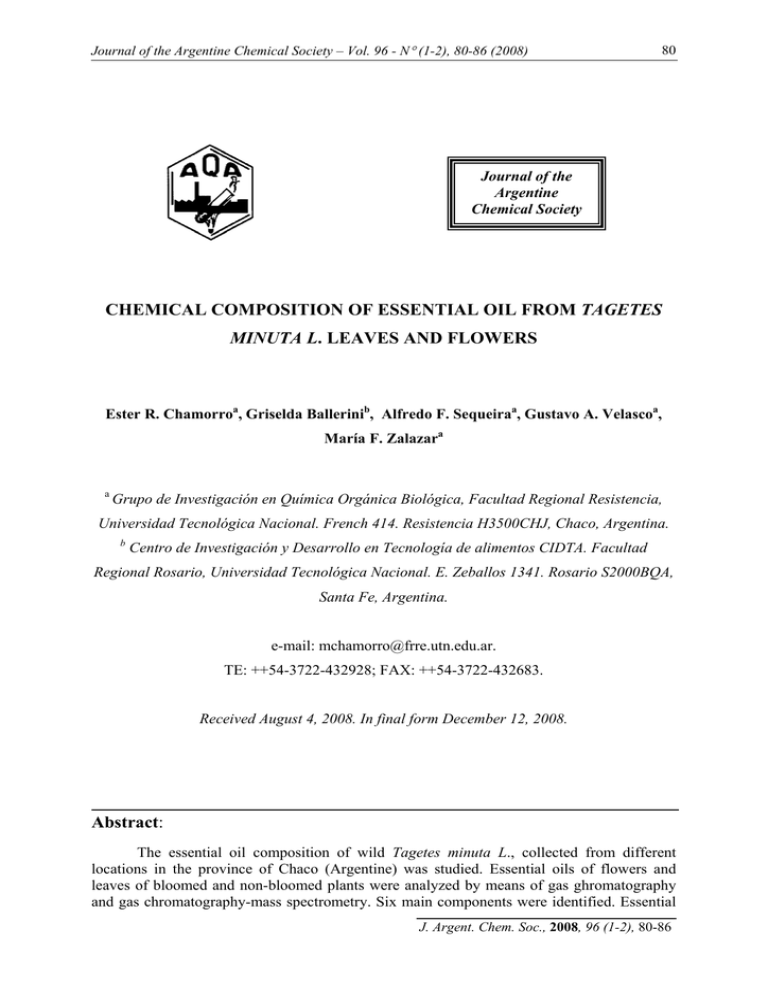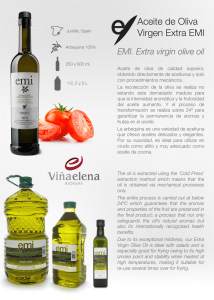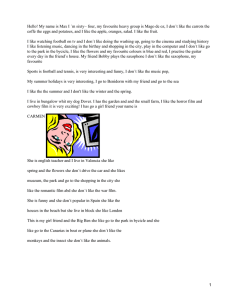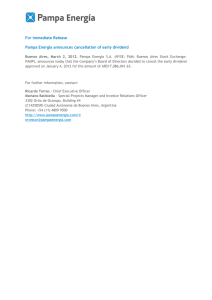Chemical composition of essential oil from Tagetes minuta L
Anuncio

Journal of the Argentine Chemical Society – Vol. 96 - N° (1-2), 80-86 (2008) 80 Journal of the Argentine Chemical Society CHEMICAL COMPOSITION OF ESSENTIAL OIL FROM TAGETES MINUTA L. LEAVES AND FLOWERS Ester R. Chamorroa, Griselda Ballerinib, Alfredo F. Sequeiraa, Gustavo A. Velascoa, María F. Zalazara a Grupo de Investigación en Química Orgánica Biológica, Facultad Regional Resistencia, Universidad Tecnológica Nacional. French 414. Resistencia H3500CHJ, Chaco, Argentina. b Centro de Investigación y Desarrollo en Tecnología de alimentos CIDTA. Facultad Regional Rosario, Universidad Tecnológica Nacional. E. Zeballos 1341. Rosario S2000BQA, Santa Fe, Argentina. e-mail: [email protected]. TE: ++54-3722-432928; FAX: ++54-3722-432683. Received August 4, 2008. In final form December 12, 2008. Abstract: The essential oil composition of wild Tagetes minuta L., collected from different locations in the province of Chaco (Argentine) was studied. Essential oils of flowers and leaves of bloomed and non-bloomed plants were analyzed by means of gas ghromatography and gas chromatography-mass spectrometry. Six main components were identified. Essential J. Argent. Chem. Soc., 2008, 96 (1-2), 80-86 81 E. R. Chamorro et al. oil from non-bloomed plant leaves contained mainly dihydrotagetone, while the essential oil from bloomed plants leaves as well as from flowers, were rich in β-ocimene and tagetenone. The essential oil composition of Tagetes minuta L. varies according to the different parts of the plant and its growth stage but does not differ with respect to the origin of the material. Kevword: tagetes minuta, essential oil, varroicide power Resumen: La composición del aceite esencial de Tagetes minuta L., obtenido de diferentes localidades de la provincia del Chaco (Argentina) fue estudiada. Los aceites esenciales fueron analizados por cromatografía gaseosa y espectrometría de masas. Seis componentes principales fueron identificados. El aceite de hojas no florecidas contiene principalmente dehidrotagetona, mientras que el aceite de hojas de plantas florecidas al igual que el aceite de flores es rico en β-ocimeno y tagetenona. La composición del aceite esencial de Tagetes minuta L. varia según las diferentes partes de la planta y de su estadío de crecimiento pero no difiere con respecto a la procedencia del material. Palabras Claves: tagetes minuta – aceite esencial – acción varroicida Introduction Tagetes minuta L. is a native aromatic plant from South America, which is well known in the province of Chaco (Argentine), and it is vulgarly called “chinchilla”. It grows naturally from spring and practically disappears with the beginning of the winter having developed its complete life cycle. This essential oil has wide applications as flavoring and in perfume. Besides, it is well known for its biocide properties. Various studies on T. minuta reported that there are variations in the essential oil composition according to the harvesting location as described by Zygadlo et al. [1]; Keitas y col. [2], the growth stage by Daghero et al [3], the different parts of the plant by Weaver et al. [4] and that there are different chemotypes within the species as described by Gil et al. [5]. All these facts, make a deep study necessary of the native T. minuta essential oil at regional level. In connection with our ongoing interest on the study an alternative control of the Varroa destructor, an ectoparasitary mite of the Apis mellífera, with essential oils and considering that there are reports which present the T. minuta essential oil as an effective biocide, Zygadlo et al. [6]; Vasudevan et al. [7] and Hethelyi, et al. [8], we describe in the present work a study of the chemical composition of essential oil from Tagetes minuta L. leaves and flowers. Materials and methods The vegetable material, from different locations of the province of Chaco (Juan Jose Castelli, Puerto Tirol, La Leonesa, Gral. San Martin, Las Breñas, Basail, Pres. R. S. Peña, Pampa del Indio and Makalle) was collected during the fall of the years 2003-2004. In this time the plant is in full swing, which can be used for the extraction of essential oil. Chemical composition of essential oil from... 82 The collected material was classified and separated into two fractions, leaves and flowers. The material was aired for 24 hours in a well-ventilated and protected from direct sunlight. The essential oil was obtained by steam-distillation, independently, from non-bloomed plant leaves (n= 9, where n is the sample number), from bloomed plant leaves (n= 21) and from flowers (n= 50) of T. minuta. Dry essential oils were refrigerated and kept in brown glass jars. The essential oil obtained was analyzed qualitatively and quantitatively by means of gas chromatography (GC). The quantitative data were determinated from the peak-percentage areas without correction factors. A Shimadzu GC 14B gas chromatograph equipped with a column Mega Bore DB-WAX P/N 125-7032 (30 m x 0.53 mm i.d. x 1 μm film thickness) and FID detector was used. The column was programmed as follows: 60 ºC during 5 minutes, increased to 200 °C at 10 °C/min. Injector temperature was 180 °C and detector temperature was 220 °C. Peak area percentages were calculated with a Shimadzu C-R6A Chromatopac Integrator without including response factors or internal standards. The components of interest of essential oils obtained from leaves (non-bloomed and bloomed) and flowers were separated by column chromatography (adsorbent Alumina WN-3 Neutra - Activity Grade II), used as elution solvent n-Hexane and ethyl ether free peroxides. The identification of the same was carried out by gas chromatography-mass spectrometry (GC-MS) using a gas chromatograph Agilent 6890 with selective mass detector Agilent 5973 with a capillary column of HP-5MS (30 m x 0.25 mm i.d. x 0.25 μm film thickness) and a split/splitless injector, with an automatic injection system ALS Agilent 7683, Library NIST Mass Spectral Search Program, version 1.6d. Working conditions were: split injection; ratio 70:1, injecting 0.2 μl. The test was carried out at 250ºC, the oven at initial 50ºC for 2 minutes increasing 10 ºC per minute till 200ºC were reached. The flow gas was of 0.7 μl/min at constant speed of 30 cm/s with a 250ºC interface. Results and discussion Table 1 shows the qualitative and quantitative analyses of the essential oils obtained from Tagetes minuta. Show six main components, they represent more than 90 % of Tagetes minuta essential oil. The main components were identified as: β-phelandrene (1), limonene (2), β-ocimene (3), dihydrotagetone (4), tagetone (5) and tagetenone (6). The components of interest, isolated by column chromatography and identified by GCMS were β-ocimene and tagetenone, from flowers essential oil and dihydrotagetone from essential oil leaves of non-bloomed plants. From a quantitative point of view, the essential oil from flowers was observed to contain a larger amount of tagetenone and β-ocimene than the essential oil from the leaves. On the contrary, essential oil leaves of non-bloomed plants contains dihydrotagetone as the main component. When the plant blooms, the dihydrotagetone content in leaves essential oil decreases, while tagetenone and β-ocimene quantities increases (see Table 1). Tables 2 and 3 show that the major components, and hence our interest, not differ with respect to the origin of plant material, both in the essential oil leaves of non-bloomed plants and in the essential oil flowers (Tables 2 and 3) (Figs 1 and 2). 83 E. R. Chamorro et al. Table 1: Mean value of the chemical composition of essential oil from T. minuta L. leaves and flowers according to the growth stage. Between brackets standard deviation, n is the sample number. Component and Retention time (Seg) . 1 2 3 4 β-phelandrene 1.76 – 2.11 limonene 2.74 – 3.35 β-ocimene 3.51 – 4.29 dihydrotageton e Leaves nonbloomed plant oil n=9 March Leaves bloomed plant oil n=14 April-May Leaves bloomed / fructified plant oil n=7 June Flower oil n=4 April Flower oil n=19 May Lower and seed oil n=27 June 2.6 (0.5) 1.7 (0.3) 2.0 (0.7) 1.5 (0.8) 1.1 (0.4) 1.2 (0.5) 13.1 (2.8) 10.3 (3.0) 11.1 (3.7) 7.0 (3.1) 6.4 (1.7) 7.0 (3.6) 11.5 (2.7) 17.5 (16.6) 19.8 (8.2) 45.4 (3.0) 39.6 (7.4) 36.4 (13.1) 42.9 (10.5) 30.3 (16.9) 25.2 (15.8) 7.7 (7.1) 7.5 (2.8) 10.3 (5.4) 16.8 (2.6) 16.6 (8.8) 14.5 (5.3) 5.6 (2.2) 7.8 (2.7) 10.2 (4.3) 11.7 (6.9) 16.0 (12.2) 21.3 (13.7) 25.0 (13.1) 32.9 (8.3) 28.7 (5.4) 98.6 92.4 93.9 92.5 95.3 93.8 5.35 – 6.45 5 6 tagetone 9.29 – 9.94 tagetenone 11.90 – 12.50 Total (%) Table 2: Variation of the chemical composition of essential oil from T. minuta L. leaves nonbloomed plants according to harvesting location. Recollection date: March 2003 (n= 9). Component (%) Harvesting location 1 2 3 4 5 6 Juan Jose Castelli 2,71 12,77 8,25 54,66 16,71 4,94 Juan Jose Castelli 2,74 12,20 9,26 53,40 16,26 5,37 Juan Jose Castelli 2,91 13,60 10,20 53,20 15,58 4,47 Puerto Tirol 1,37 7,13 8,42 48,72 19,13 9,67 La Leonesa 2,59 13,07 12,59 35,18 17,33 15,69 La Leonesa 2,87 18,05 16,46 42,70 10,97 8,94 La Leonesa 2,81 13,24 12,55 41,11 16,28 12,52 Gral. San Martin 2,34 12,84 11,79 32,18 18,80 20,32 Gral. San Martin 2,77 14,60 14,09 25,29 19,84 23,38 2,6 (0,5) 13,1 (0,8) 11,5 (2,7) 42,9 (10,5) 16,8 (2,6) 11,7 (6,9) Mean value (standard deviation) Chemical composition of essential oil from... 84 Table 3: Variation of the chemical composition of essential oil from T. minuta L. Flower according to harvesting location. Recollection date: May 2003-2004 (n = 19). Harvesting location Component (%) Makalle Makalle Las Breñas Las Breñas Basail Basail Makalle Makalle Pres. R. S. Peña Pres. R. S. Peña Basail Basail Basail Pampa del Indio Pampa del Indio Pampa del Indio Makalle Makalle Makalle Mean value (standard deviation) 1 1,10 1,04 2,50 1,13 1,10 1,24 0,80 0,83 0,76 1,25 0,79 1,08 0,78 0,66 0,45 0,78 1,04 1,30 1,68 2 5,50 5,59 7,83 11,05 5,86 6,01 4,63 4,78 4,80 8,14 5,04 6,33 5,01 7,29 5,99 6,56 5,04 6,10 9,77 3 33,47 37,26 32,25 39,13 48,62 49,81 35,48 35,75 35,71 34,12 43,61 55,28 42,99 36,23 28,76 28,35 43,29 43,90 48,18 4 8,09 8,10 6,22 6,20 3,87 4,48 6,45 6,60 6,45 9,92 7,08 7,43 6,83 4,31 6,73 6,57 9,60 14,30 14,05 5 9,89 10,67 7,57 5,12 5,62 5,61 9,72 10,15 10,05 14,43 8,61 7,29 9,00 3,11 8,16 5,95 6,20 6,70 3,93 6 34,70 33,76 42,95 33,03 27,17 30,18 36,13 35,93 36,45 29,29 28,07 19,01 27,13 44,80 45,97 47,48 28,60 21,50 21,19 1,1 (0,4) 6,4 (1,7) 39,6 (7,4) 7,5 (2,8) 7,8 (2,7) 32,8 (8,3) Juan Jose Castelli Puerto Tirol La Leonesa Gral. San Martín 60,0 50,0 40,0 % 30,0 20,0 10,0 0,0 1 2 3 4 5 6 component Figure 1. Variation of the chemical composition of essential oil from leaves nonbloomed plant according to harvesting location. 85 E. R. Chamorro et al. Makalle Las Breñas Basail R. S. Peña Pampa del Indio 60,0 50,0 40,0 % 30,0 20,0 10,0 0,0 1 2 3 4 5 6 component Figure 2. Variation of the chemical composition of essential flower oil according to harvesting location Conclusions The composition of the Tagetes minuta L. essential oil from the province of Chaco varies according to the different parts of the plant and its growth stage, reaching a maximum of 42.9 % of dihydrotagetone in essential oil leaves of non-bloomed plants and 45.4 % of βocimene and 32.9 % of tagetenone in the essential oil from flowers. Although the dihydrotagetone concentration in leaves essential oil before blooming and after fructification is similar, this concentration descends below 30 % during the bloomed stage together with an increase of β-ocimene and tagetenone. As regards these results, it will be necessary, when testing the essential oil potential biocide uses, to consider these composition differences. Acknowledgements We thank Mrs. Antonia E. Díaz for his collaboration. References [1]. J. A. Zygadlo, D. M. Maestri, L. Ariza Espinar, Journal of Essential Oil Research, 1993, 51, 85. [2]. S. Kéïta, C. Vincent, J. P. Schmit, S. Ramaswamy, A. Bélanger, Journal of Storred Prodructs Research, 2000, 36, 355. Chemical composition of essential oil from... 86 [3]. J. Daghero, M. Mattea. Aceite Esencial de Tagetes minuta de la zona de Río Cuarto, cambios en la composición química en los distintos estadios de crecimiento. X CONGRESO NACIONAL SAIPA, LA PLATA, 1996. [4]. D. K. Weaver, C. D. Wells, F. V. Dankel, W. Bertsch, S. E. Sing, S. Sirharan, J. Econ. Entomol., 1994, 87, 1718. [5]. A. Gil, C. M. Ghersa, S. Leicach, Biochemical Systematics and Ecology, 2000, 28, 261. [6]. J. A. Zygadlo, Journal of Essential Oil Research, 1994, 6, 617. [7]. P. Vasudevan, S. Kashyap, S. Sharma, Bioresource Technology, 1997, 62, 29. [8]. E. Hethelyi, B. Danos, P. Tetenyi, L. Koczka, Flavour Frag. Journal, 1986, 1, 169.





